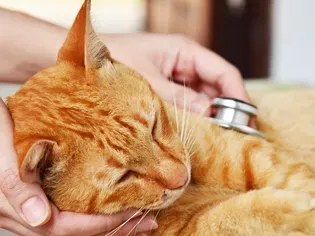7 Signs That Your Cat Is in Pain
Updated on 04/26/24

7 Unmistakable Signs Your Feline Companion is Enduring Pain
Our beloved feline friends are masters of stoicism, often concealing their discomfort with remarkable resilience. However, there are subtle signs that can reveal when your cat is silently suffering. By recognizing these indicators early on, you can provide your furry companion with the timely care they deserve.
1. Changes in Activity Patterns:
* Reduced Activity: Cats that are in pain may become less active, avoiding jumping, climbing, or running.
* Limping or Lameness: Pain in a specific limb can cause limping or difficulty walking.
* Difficulty Jumping: A reluctance to jump up on furniture or other high surfaces could indicate pain in the joints or muscles.
2. Behavioral Clues:
* Irritability or Aggression: Pain can make cats irritable and aggressive, leading to unexpected hissing or biting.
* Excessive Grooming: Cats may excessively groom an area that is causing them pain, attempting to alleviate discomfort.
* Hiding or Isolation: When in pain, cats may seek seclusion and hide away from human interaction.
3. Changes in Appetite:
* Loss of Appetite: Pain can reduce appetite, leading to weight loss and lethargy.
* Changes in Water Intake: Increased thirst can be a sign of pain associated with urinary tract problems.
4. Physical Indicators:
* Dilated Pupils: Enlarged pupils can indicate pain or discomfort.
* Increased Heart or Respiratory Rate: Elevated heart or respiratory rate can be a general indicator of physical stress or pain.
* Body Posture: Cats in pain may adopt unusual body postures, such as hunching their back or arching their spine.
5. Vocalizations:
* Meowing or Howling: Cats may vocalize more frequently or in a higher pitch when in pain.
* Quiet or Muted Sounds: Conversely, some cats may become quieter than usual when experiencing discomfort.
6. Litter Box Habits:
* Difficulty Urinating or Defecating: Pain in the urinary tract or lower back can make it difficult for cats to use the litter box.
* Inappropriate Elimination: Cats in pain may eliminate outside the litter box due to discomfort or difficulty reaching it.
7. Facial Expressions:
* Widened Eyes: Cats with pain may have wider-than-normal eyes, indicating distress or discomfort.
* Flattened Ears: Flattening the ears against the head can be a sign of pain, fear, or aggression.
* Raised Lip: A curled lip may indicate pain in the mouth or jaw.
Examples of Painful Conditions in Cats:
* Arthritis: Joint pain due to inflammation.
* Trauma: Injuries from falls, fights, or accidents.
* Urinary tract infections: Painful urination due to bacteria or crystals.
* Dental disease: Painful tooth infections or gum disease.
* Gastrointestinal issues: Pain from vomiting, diarrhea, or constipation.
Conclusion:
Recognizing the signs of pain in cats is crucial for their well-being. By being observant and attuned to their behavior, you can ensure that your feline companion receives the necessary veterinary care in a timely manner. Remember, cats are masters of disguise when it comes to showing pain, so even subtle changes in their demeanor should warrant attention. By addressing their discomfort early on, you can help them regain their vibrant and playful selves, ensuring a long and happy life together.
Explore More Pets

Cat Behavior Problems
How to Stop Aggression in Kittens

Long-Haired Cat Breeds
Siberian Cat: Breed Profile, Characteristics, & Care

Cat Behavior Problems
How to Stop Kittens From Scratching and Biting

Long-Haired Cat Breeds
Turkish Angora: Cat Breed Profile, Characteristics & Care

Basic Training
How to Socialize Your Kitten

Short-Haired Cat Breeds
Cute Pictures & Facts About Calico Cats & Kittens

Litter Box Training
Training Your Kitten to Use the Litter Box

Long-Haired Cat Breeds
10 Fun Facts About White Cats